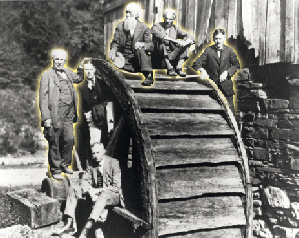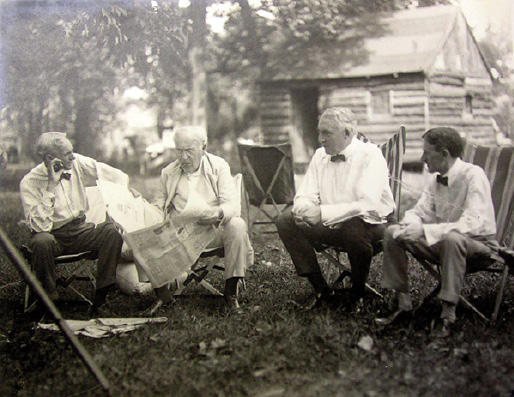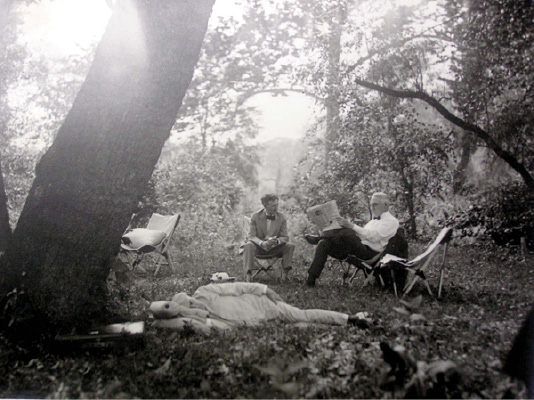Chapter Nine
The Four Vagabonds

Exploring an old mill in Virginia are (left to right) Thomas Edison, Harvey Firestone, Jr., R.J.H. DeLoach, John Burroughs, Henry Ford, and Harvey Firestone.
While Edison was known for working almost constantly in his lab, often neglecting his family, and even giving up sleep in order to get more done, he did leave the lab once in a while for rest and relaxation. Almost yearly between 1914 and 1924, Edison went on vacation and toured the nation on weeks-long camping trips with his best friends: automotive pioneer Henry Ford, rubber tire developer Harvey Firestone, and renowned nature writer John Burroughs (who only took part in the fun until his death in 1921).
When this unlikely group of celebrity companions hit the road to trek through forested mountain trails and pitch tents in the great outdoors, the entire country paid attention. Newspapers dubbed them “Wizards of the Wilds,” but the travel pals referred to themselves as “the Four Vagabonds.”
They vacationed with a huge caravan of glamorous new cars and custom-built trucks that hauled food and gear, with Edison, as their chosen navigator and guide, driving in the lead. Their parade included a Ford Lincoln truck rebuilt into a kitchen on wheels, complete with icebox and gasoline-powered stove. They even hired a gourmet chef to cook for them on the road.
Under a giant dining tent, the four enjoyed luxurious meals on a circular, nine-foot wooden lazy Susan table. Today, that table still bears the signatures of many honored guests, including the Vagabonds, their family members, and even U.S. president Warren G. Harding.
Five hired helpers usually accompanied the group. Their tasks were to assemble tents and chauffeur vehicles. When the travelers stopped—which was often—for a meal and a nap, a miniature city was erected: 20 large sleeping tents swathed in mosquito netting and labeled with their famous names.

President Warren G. Harding (second from right) relaxes with (left to right) Ford, Edison, and Firestone on a Vagabond expedition.
The four men brought many comforts from home. Edison’s dream of illuminating America came alive when he carted electric lights and a storage battery into the wilderness. Bathed in the glow from the lights, Edison enjoyed reading books and magazines in his tent until midnight, when he would stop to observe the stars. On one trip, the Vagabonds even brought an electric player piano for entertainment!
Their fancy equipment and wacky stunts delighted and shocked observers. Newspaper reporters, photographers, and curious locals gathered to gape at these four famous fellows covered in road dust. As savvy businesspeople, Edison, Ford, and Firestone relished the publicity.
Ford’s own motion picture company followed the Vagabonds to film travelogues, which were short films (resembling today’s television commercials) played prior to a movie in theaters. Viewers were entertained by watching the Vagabonds compete to see who could run, chop wood, and climb trees the fastest.
Just like most friends, the Vagabonds fought and argued about topics such as music, books, and politics. They even quibbled about one another’s diets: Ford believed Burroughs’s favorite caramel candies were unhealthy, so he threw them away. And Burroughs grumbled that Edison ate too much pie and put too much sugar in his coffee.
They all complained that Edison chose roundabout routes and bumpy dirt roads. As Firestone put it, nobody including Edison ever knew for sure where they were going! But as Burroughs wrote, “All cheerfully endure[d] wet, cold, smoke, mosquitoes, black flies, and sleepless nights” in the quest for adventure.
Once, the Vagabonds accidentally camped on private property. Firestone had to convince an angry woman that the man reading a newspaper on her lawn really was Thomas Edison. Another time Edison picked what he thought was a quiet, remote, wooded camping spot. That night, the men were wakened by the clanging bell and roar of a steam train rumbling right next to their tents. The following day, Ford “borrowed” the train and took it for a spin with Edison perched on the front.
Sometimes, Edison took one of his famous sudden and sound naps under a tree, but usually, he scouted nature for inspiration. The outdoors served as his laboratory, through which this man with the wrinkled clothes and uncombed hair endlessly wandered. Edison smashed rocks with hammers in search of gold and valuable minerals and sliced plants to see if their sap could be made into rubber.

Edison enjoys one of his famous naps while the president catches up on the news.
Even rivers and brooks spoke to Edison’s inventive imagination. As Firestone wrote, “I doubt if, on our trips, we ever passed an abandoned mill without Mr. Edison and Mr. Ford getting out to measure the force of the stream, inspect the old wheel, and talk about ways and means of putting the waste power to work.”
Many historians believe that the Vagabonds’ trips marked some of the first times automobiles played a central role in outdoor recreation. Today, such activities have become widely celebrated and enjoyed American traditions.
Edison certainly knew how to make things work, but he also knew how to play. As a member of the Four Vagabonds, he applied his genius to having fun and taking camping to a new level in this country.